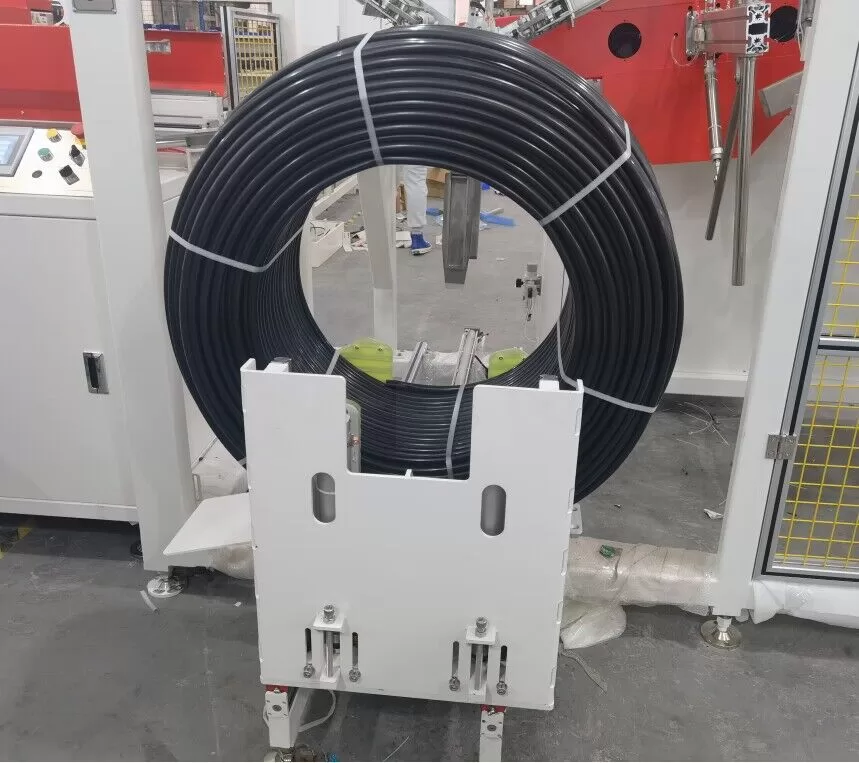Optimizing Hose Production: The Role of Automatic Coiling and Strapping Systems
In modern manufacturing, particularly within extrusion lines producing plastic pipes, tubes, and hoses, efficiency, consistency, and labor optimization are paramount. Manual or semi-automatic coiling and handling processes can create bottlenecks, increase labor costs, and lead to inconsistencies in final product packaging. Implementing automated solutions, specifically automatic coiling and strapping machines, offers a significant advantage.
What is an Automatic Hose Coiling and Strapping Machine?
An automatic coiling and strapping machine is an integrated system designed to automate the end-of-line process for flexible products like hoses and pipes. Directly connected to an extruder or operating offline, this equipment manages the winding of the product into neat coils of predetermined lengths and secures these coils, typically using plastic strapping, preparing them for storage or shipment. These systems are engineered to handle a variety of materials, including polyethylene (PE), polyvinyl chloride (PVC), and high-density polyethylene (HDPE) hoses, among others.
Key Automated Processes
These sophisticated machines typically automate several critical steps:
- Length Measurement: Precisely calculates the desired length of the hose or pipe for each coil using integrated sensors or encoders.
- Cutting: Automatically cuts the product once the target length is reached, ensuring uniformity.
- Coil Formation (Winding): Feeds the hose onto a coiling head or drum, forming a tightly wound, consistent coil according to preset parameters (e.g., coil diameter, traverse width).
- Coil Securing (Strapping): Applies one or more straps around the finished coil at specified positions to maintain its shape and prevent unwinding during handling. The number of straps and their tension are often adjustable.
- Coil Ejection/Handling: Automatically releases the strapped coil from the winding head, often transferring it to a conveyor, palletizer, or collection area.

automatic pipe coiling machine, automatic hose coiling machine3 Core Benefits of Implementing Automation
Transitioning from manual or semi-automatic methods to a fully automatic coiling and strapping system yields substantial operational improvements:
- Increased Throughput and Efficiency: Automation allows for continuous operation synchronized with the extrusion line's speed, eliminating manual bottlenecks and significantly boosting overall production output.
- Reduced Labor Costs: A single operator can often oversee the automated system, freeing up personnel previously required for manual coiling, cutting, strapping, and handling tasks.
- Improved Coil Consistency and Quality: Automated systems produce uniform coils with consistent dimensions and secure strapping, reducing issues related to loose or irregular packaging and enhancing product presentation.
- Enhanced Workplace Safety: Minimizes manual handling of potentially heavy or unwieldy coils, reducing the risk of repetitive strain injuries and other workplace accidents.
- Process Integration and Control: Advanced systems often feature PLC (Programmable Logic Controller) controls, allowing for easy setup, adjustment of parameters (like coil length, diameter, strapping positions), diagnostics, and integration with upstream and downstream production equipment.
Technical Considerations
When evaluating automatic coiling systems, key features and capabilities include:
- Material Handling Range: The ability to process different hose/pipe diameters, weights, and flexibility levels.
- Coiling Configuration: Options for different coil inside/outside diameters and widths.
- Strapping Options: Number of straps, type of strap material, tension control.
- Control Systems: User interface, programming flexibility, connectivity for data exchange.
- Design Standards: Conformance to relevant industry standards and safety guidelines (e.g., CE marking).

automatic pipe coiling machine, automatic hose coiling machine2 Conclusion
Automatic coiling and strapping machines represent a vital technology for manufacturers in the hose and pipe industry seeking to optimize their production lines. By automating the labor-intensive end-of-line processes, these systems deliver significant gains in efficiency, product quality, cost reduction, and safety. Investing in this technology is a strategic step towards streamlining operations and maintaining competitiveness in today's demanding manufacturing environment.
